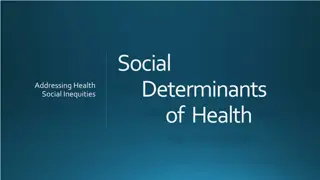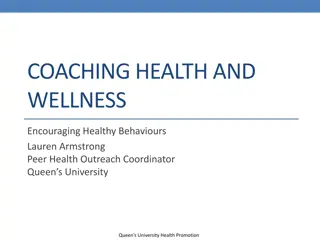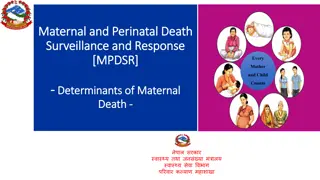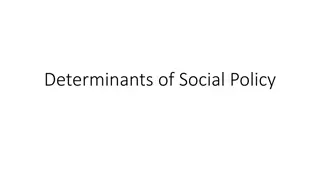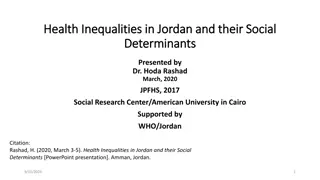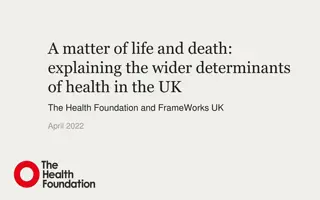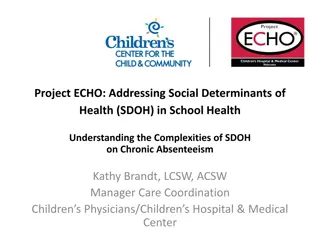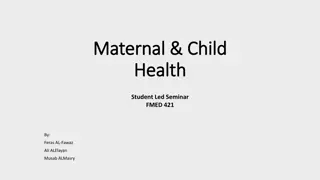Understanding the Determinants of Health: Exploring Factors Influencing Well-being
Explore the intricate web of factors affecting health and well-being, from socioeconomic and environmental influences to genetic predispositions. Learn about the social determinants of health and their impact on individual and population well-being. Gain insights into why framing health in societal terms is crucial for addressing health inequities. Dive into the discussion on how societal conditions shape health outcomes and the responsibilities of governments in upholding the health of their populations.
Download Presentation

Please find below an Image/Link to download the presentation.
The content on the website is provided AS IS for your information and personal use only. It may not be sold, licensed, or shared on other websites without obtaining consent from the author. Download presentation by click this link. If you encounter any issues during the download, it is possible that the publisher has removed the file from their server.
E N D
Presentation Transcript
THE DETERMINANTS OF HEALTH 1 MODULE 1 PART 2 Introduction and the Determinants of Health
LEARNING OBJECTIVES 1 Explain the concepts of health and well-being 1 Recognize the responsibility of states to uphold the health of their population 2 Identify the socioeconomic, biological and behavioural factors that influence health 3 Explain the social determinants of health 4
DEFINITION OF HEALTH 1 Health is a state of complete physical, mental and social well-being, and not merely the absence of disease or infirmity (World Health Organization, 1948). Health is an individual right and a social justice issue. It is also a public good. Governments have a responsibility for the health of their peoples which can be fulfilled only by the provision of adequate health and social measures.
FACTORS DETERMINING HEALTH 1 Clinical care is less important than many people think whereas socioeconomic factors and the physical environment are quite influential on health and well-being. Genetic characteristics are also less significant than many people think. Whether people are healthy or not, is determined by their circumstances and environment the social, economic and environmental conditions which affect the health of the population.
WHY FRAME HEALTH IN TERMS OF SOCIETAL CONDITIONS? 1 IMPACT: 30 - 50% OR MORE Canadian Institute of Advanced Research (2012) Mc Giniss et al (2002) Health care (up to 15%) Health care (up to 25%) Social circumstances & environmental exposure (45%) Socioeconomic (50%) Environmental (10%) Health behaviour patterns (40%) Genetics (15%) Figure: Estimates of the contribution of the main drivers of health status. Source: Donkin, A., P. Goldblatt, J. Allen, V. Nathanson and M. Marmot (2017). "Global action on the social determinants of health." BMJ Global Health.
WHAT ARE THE SOCIAL DETERMINANTS OF HEALTH? 1 The social determinants of health are the conditions in which people are born, grow, live, work and age. These circumstances are shaped by the distribution of money, power and resources at global, national and local levels. The social determinants of health are mostly responsible for health inequities the unfair and avoidable differences in health status seen within and between countries. The social determinants of health are multi-layered and range from societal to individual factors.
THE SOCIAL DETERMINANTS OF HEALTH 1 Source: Dahlgren G and Whitehead M (1991) Policies and strategies to promote social equity in health. Stockholm, Institute of Future Studies.
SOCIAL DETERMINANTS OF HEALTH CONCEPTUAL FRAMEWORKS 1 Global Commission on SDH (2008) PAHO Equity Commission (2019) Dahlgren & Whitehead (1991)
GLOBAL COMMISSION ON SOCIAL DETERMINANTS OF HEALTH CONCEPTUAL FRAMEWORK (2008) 1 SOCIOECONOMIC POLITICAL CONTEXT SOCIOECONOMIC POSITION Material Circumstances (Living and Working, Conditions, Food Availability, etc.) Governance Macroeconomic Policies IMPACT ON EQUITY IN HEALTH AND WELL-BEING SOCIAL CLASS GENDER ETHNICITY (RACISM) Behaviours and Biological Factors Social Policies Labour market, Housing, Land Psychosocial Factors EDUCATION Public Policies, Education, Health, Social protection Social cohesion & Social capital OCCUPATION Culture and Societal value HEALTH SYSTEM INCOME STRUCTURAL DETERMINANTS OF HEALTH INEQUITIES INTERMEDIARY DETERMINANTS OF HEALTH
PAHO CONCEPTUAL FRAMEWORK ON SOCIAL DETERMINANTS OF HEALTH AND HEALTH EQUITY (2019) 1 INTERSECTIONALITY: SOCIAL AND ECONOMIC INEQUITIES, GENDER, SEXUALITY, ETHNICITY, DISABILITY, MIGRATION STRUCTURAL DRIVERS CONDITIONS OF DAILY LIFE Early Life and Education Political, Social, Cultural and Economic Structures Working Life Natural Environment, Land and Climate Change Older People Income and Social Protection HEALTH EQUITY AND DIGNIFIED LIFE History and Legacy, Ongoing Colonialism, Structural Racism Violence Environment and Housing Health Systems TAKING ACTION Governance Human Rights Source: Pan American Health Organization. Just Societies: Health Equity and Dignified Lives. Report of the Commission of the Pan American Health Organization on Equity and Health Inequalities in the Americas. Washington, D.C.: PAHO; 2019.
ACTION RECOMMENDATIONS 1 Global Commission on SDH (2008) 3 overarching recommendations PAHO Equity Commission (2019) 12 recommendations
PRIORITY RECOMMENDATIONS: THE GLOBAL COMMISSION 1 The World Health Organization s Commission on Social Determinants of Health final report (2008) contains three overarching recommendations - Improve daily living conditions: the circumstances in which people are born, grow, live, work, and age 1 Tackle the inequitable distribution of power, money and resources: the structural drivers of those conditions of daily life globally, nationally, and locally 2 Measure and understand the problem and assess the impact of action: expand the knowledge base, develop a workforce that is trained in the social determinants of health, and raise public awareness about the social determinants of health 3
PRIORITY RECOMMENDATIONS: PAHO COMMISSION 1 The 12 recommendations include priority objectives and specific measures in the following general categories: STRUCTURAL DRIVERS: INEQUITIES IN POWER, MONEY, AND RESOURCES Achieving equity in political, social, cultural, and economic structures 1 Protecting the natural environment, mitigating climate change, and respecting relationships to land 2 Reversing the health equity impacts of ongoing colonialism and structural racism 3
PRIORITY RECOMMENDATIONS: PAHO COMMISSION 1 CONDITIONS OF DAILY LIFE 4 Equity from the start: Early life and education 5 Decent work 6 Dignified life at older ages 7 Income and social protection 8 Reducing violence for health equity 9 Improving environment and housing conditions 10 Equitable health systems
PRIORITY RECOMMENDATIONS: PAHO COMMISSION 1 GOVERNANCE FOR HEALTH EQUITY 11 Governance arrangements for health equity 12 Fulfilling and protecting human rights
End of Module 1 Part 2 Please continue to Module 2 Part 1


